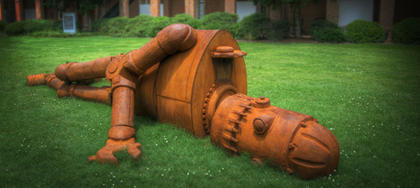The Latest from Boing Boing |  |
- Researchers expand clinical study of brain implant
- Giant code wheel for sale, proceeds to EFF
- Turn zombie game into Benny Hill game
- You get better results asking for stuff when you talk to the right ear
- Britain's secret plan for surviving a nuclear war
- Woodsy themed laptop and iPhone cases
- Bozeman, Montana changes its mind about job applicants' social networking passwords
- Goopymart's paper taco trucks
- Canadian government expresses cautious enthusiasm for Internet
- Comatose robot symbolizes the de-industrialization of America
- Why "new novelists" are all old
- Squelettes: buildings that never made it
- Price Is Right's midcentury modern tech
- Moussavi the architect
- The Pyramid of North Dakota
- Dancing manias
- Water drums for kids
- Today at Boing Boing Gadgets
- Half-man / half-Pooh Bear takes a break next to decapitated patriotic Mickey Mouse
- Tadpoles falling from the sky in Japan?
- Jury reports that Steon's Orbo does not produce free energy
- Connections: Atlas Obscura Edition
- Mathematically modelling phantom traffic jams
- Boing Boing Video gets a website makeover, a guest tweet-blog, and a new url: boingboingvideo.com
- A library of the world's most unusual compounds
- Today on Offworld: the 15 games you need for your new iPhone
- Nanoscale gear
- Girl who claimed her face was tattooed while sleeping comes clean
- Consumer groups around the world demand transparency on secret copyright treaty
- BB Video: "Ssshhh," by Hess is More, dir: m ss ng p eces (music video)
| Researchers expand clinical study of brain implant Posted: 24 Jun 2009 04:01 AM PDT Joshua Foer is a guest blogger on Boing Boing. Joshua is a freelance science journalist and the co-founder of the Atlas Obscura: A Compendium of the World's Wonders, Curiosities, and Esoterica, with Dylan Thuras.  I'm excited to see that the BrainGate Neural Interface System is moving to phase-II clinical testing. BrainGate is: A baby aspirin-size brain sensor containing 100 electrodes, each thinner than a human hair, that connects to the surface of the motor cortex (the part of the brain that enables voluntary movement), registers electrical signals from nearby neurons, and transmits them through gold wires to a set of computers, processors and monitors. The goal is for patients with brain stem stroke, ALS, and spinal cord injuries to eventually be able to control prosthetic limbs directly form their brains. An earlier version of the BrainGate system helped a young tetraplegic named Matt Nagle control a mouse cursor and operate a very basic prosthetic hand. Last fall, I met a 25-year-old locked-in patient named Erik Ramsey, who is participating in the only other FDA-approved clinical trial of a brain-computer interface. Ever since a car accident nine years ago, the only part of Erik's body that has been under his control has been his eyeballs, and even those he can only move up and down. The hope is that he might someday use his neural implant to control a digital voice: When Erik thinks about puckering his mouth into an o or stretching his lips into an e, a unique pattern of neurons fires--even though his body doesn't respond. It's like flicking switches that connect to a burned-out bulb. The electrode implant picks up the noisy firing signals of about fifty different neurons, amplifies them, and transmits them across Erik's skull to two small receivers glued to shaved spots on the crown of his head. Those receivers then feed the signal into a computer, which uses a sophisticated algorithm to compare the pattern of neural firings to a library of patterns Kennedy recorded earlier. It takes about fifty milliseconds for the computer to figure out what Erik is trying to say and translate those thoughts into sound.Like the BrainGate sensor, Erik's neural implant was inserted into the motor cortex (in his case, the specific region that controls the mouth, lips, and jaw). But Erik's implant only has a single electrode, whereas the BrainGate has 100, which means it should, theoretically, be able to differentiate signals from a far greater number of neurons. Plug and Play: Researchers Expand Clinical Study of Neural Interface Brain Implant The Unspeakable Odyssey of the Motionless Boy |
| Giant code wheel for sale, proceeds to EFF Posted: 24 Jun 2009 03:59 AM PDT The Mythbusters gang built a gigantic code-wheel for a demo at the RSA conference and now they're auctioning it off, with proceeds to the Electronic Frontier Foundation: Coding Cryptex built by Adam Savage and Jamie Hyneman (via Make) |
| Turn zombie game into Benny Hill game Posted: 24 Jun 2009 01:21 AM PDT StevenF has a great lazyweb idea: a simple game-mod would turn the terrifying and brilliant multiplayer zombie combat game Left 4 Dead into Benny Hill, the Game: 1. Start with "Left 4 Dead"this is stevenf.com (via Wonderland) |
| You get better results asking for stuff when you talk to the right ear Posted: 23 Jun 2009 11:23 PM PDT Researchers at University "Gabriele d'Annunzio" in Chieti, Italy have published the results of three cleverly designed studies that indicate that humans are more apt to act on information heard through their right ears than through their left. Tommasi and Marzoli's three studies specifically observed ear preference during social interactions in noisy night club environments. In the first study, 286 clubbers were observed while they were talking, with loud music in the background. In total, 72 percent of interactions occurred on the right side of the listener. These results are consistent with the right ear preference found in both laboratory studies and questionnaires and they demonstrate that the side bias is spontaneously displayed outside the laboratory.Need Something? Talk To My Right Ear |
| Britain's secret plan for surviving a nuclear war Posted: 23 Jun 2009 11:18 PM PDT Britain recently released its "War Book," detailing the national plan for life after a nuclear attack. By all accounts, it's a hair raising document, but I'm damned if I can find a copy on the web, or on the National Archives' site. Can you? Post links in the comments section, please! The country would have been divided into 12 regions, each governed by cabinet ministers with wide powers, aided by senior military officers, chief constables and judges and based in bunkers. Other senior figures would have retreated to a central government shelter under the Cotswolds.War Book reveals how Britain planned to cope with nuclear attack (via Futurismic) |
| Woodsy themed laptop and iPhone cases Posted: 23 Jun 2009 10:55 PM PDT  Yogi Bear-style Laptop sleeve and iPhone case from HunterGatherer. Very nice! HunterGatherer iPhone Case & Laptop Sleeve |
| Bozeman, Montana changes its mind about job applicants' social networking passwords Posted: 23 Jun 2009 10:46 PM PDT The town of Bozeman, Montana has rescinded its policy requiring job applicants to submit their logins and passwords for all social network sites, email accounts, etc, as part of its background check process. The city announced in a meeting (PDF) on Monday that it had suspended the practice as of Friday, June 19 and that it would update its hiring procedures within 30 days to determine a more appropriate level of screening for employees...Bozeman apologizes, backs down over Facebook login request |
| Posted: 23 Jun 2009 10:43 PM PDT  Goopymart has created a set of print-and-fold taco trucks for you to enjoy, celebrating the Taco Trucker's art even as city officials around the world struggle to stamp it out. paper taco trucks (via Andre Torrez) Previously: |
| Canadian government expresses cautious enthusiasm for Internet Posted: 23 Jun 2009 10:40 PM PDT A reader writes, "Canadian Heritage Minister James Moore gave a speech this week that appears to suggest a surprising shift in Canadian policy on copyright. Moore talked about the great opportunities presented by the Internet and how many older politicians don't understand these opportunities." For context, this is the same government that recently tried to ram through a super-restrictive version of the US Digital Millennium Copyright Act, refusing to meet with Canadian artists, filmmakers, academics, librarians or user-rights groups. As Michael Geist says, "Last year's experience with Bill C-61 left thousands of Canadians deeply disappointed with government on copyright policy. Yesterday's remarks signal an important shift with both Clement and Moore clearly committed to more open consultation and to the development of a balanced copyright bill that better reflects the real-world realities of new technologies, innovation, new creators, and the reasonable expectations of Canadian consumers." Reflecting on the Digital Economy Conference |
| Comatose robot symbolizes the de-industrialization of America Posted: 23 Jun 2009 10:36 PM PDT This huge, comatose robot sculpture graces the quad at the University of Alabama: Woods Quad Robot Sculpture Draws Attention, Provokes Thought (Thanks, Chris!) |
| Why "new novelists" are all old Posted: 23 Jun 2009 10:33 PM PDT John Scalzi explains why most "new novelists" are in their thirties or older. Amen -- my first book came out when I was 30, and I was considered a young turk: Finding an agent is a slog. One has to query the agent, wait to see if the query is accepted, and then if it is sample chapters and an outline go out in the mail. Then more waiting to see if the agent asks for more. If he or she does, it's time to send the whole manuscript and then wait again to see if he or she thinks the writer is worth their time to represent. At any point the agent can say "no," at which point our budding novelist will have to start over again.Why New Novelists Are Kinda Old, or, Hey, Publishing is Slow |
| Squelettes: buildings that never made it Posted: 23 Jun 2009 10:31 PM PDT Bruce Sterling wants a new word to describe buildings that are abandoned part way through construction due to economic bad times: *Another version is the abandoned, incomplete high-rise. Commonly a steel and cement framework is erected (because that's pretty easy), and then there's some legal or economic brouhaha and the builders just down tools and walk off. In Brazil a skeleton framework of this kind is called a "squelette."Ruins of the Present |
| Price Is Right's midcentury modern tech Posted: 23 Jun 2009 09:38 PM PDT  BB pal Drew Carey snapped the photo above in the Price Is Right studio. From Drew's Twitter stream: A patch panel from the 1950's that we still use. Surprised our studio monitors don't use vacuum tubes. :)Drew Carey on Twitter |
| Posted: 23 Jun 2009 05:52 PM PDT Joshua Foer is a guest blogger on Boing Boing. Joshua is a freelance science journalist and the co-founder of the Atlas Obscura: A Compendium of the World's Wonders, Curiosities, and Esoterica, with Dylan Thuras.
I wouldn't have ever guessed that there could be an Atlas Obscura angle on the Iran situation (the country's pigeon towers and salt-cured mummies feel rather trivial at the moment), but then along comes this slide show put together by the architecture critic James Gardner about Moussavi's life as a practicing architect: Over the past century, not a few powerful men, among them Churchill, Eisenhower, and even Hitler, have fancied themselves painters and have displayed at times a lively interest in architecture. What is different about Mir-Hossein Moussavi, Iran's leading opposition candidate, is that he has actually earned a living through these disciplines, and not in his long ago youth, but as recently as this past year, just before he sought the presidency of Iran. Unfortunately, there seem to be very few online images of Moussavi's most famous commission, the Iran Ministry of Energy building, and so the slide show is necessarily a bit speculative. The above photograph is of the Iran Art Portico on Valiasr Street in Tehran, a Moussavi project completed just before the start of the presidential campaign. |
| Posted: 23 Jun 2009 05:24 PM PDT Dylan Thuras is a guest blogger on Boing Boing. Dylan is a travel blogger and the co-founder of the Atlas Obscura: A Compendium of the World's Wonders, Curiosities, and Esoterica, with Joshua Foer.  In the middle of the expansive North Dakota landscape a small pyramid appears, but there is nothing ancient about this pyramid
More on the Atlas, and thanks Kaluz for the great submission! |
| Posted: 23 Jun 2009 03:09 PM PDT In 1374, hundreds of people along the River Rhine compulsively danced for days at a time, swept up in a terrifying mania of mass, compulsive, dancing. The hysteria spread through north-Eastern France and the Netherlands, lasting for months. Similar "dancing epidemics" broke out over the next two centuries. The new issue of The Psychologist features a scientific look at this incredibly strange kind of hysteria. From The Psychologist: An important clue to the cause of these bizarre outbreaks lies in the fact that they appear to have involved dissociative trance, a condition involving (among other things) a dramatic loss of self-control. It is hard to imagine people dancing for several days, with bruised and bloodied feet, except in an altered state of consciousness. But we also have eyewitness evidence that they were not fully conscious. Onlookers spoke of the dancing maniacs of 1374 as wild, frenzied and seeing visions. One noted that while 'they danced their minds were no longer clear' and another spoke of how, having wearied themselves through dancing and jumping, they went 'raging like beasts over the land' (Backman, 1952). The hundreds of possessed nuns described in chronicles, legal records, theological texts or the archives of the Catholic Inquisition were equally subject to dissociative trance (Newman, 1998; Rosen, 1968). Some may have simulated the behaviour of the demoniac as a means of eliciting positive attention (Walker, 1981), but the detailed descriptions of astute and cautious inquisitors leave little doubt that most were genuinely entranced."Looking Back: Dancing plagues and mass hysteria" (via Mind Hacks) |
| Posted: 23 Jun 2009 02:53 PM PDT  My 3-year-old is pretty deep into music -- listening to it, playing instruments, talking about songs, etc. Sometimes it's hard to get him away from his djembe and into the bathtub. My wife found Tub Tunes Water Drums and they are a huge, er, hit with my son. The idea is simple. The plastic drums float on the surface of the water and you can vary the pitch by raising or lowering the water level inside them. The tone is pretty terrific too. They're only $12 to buy on Amazon (or you could probably make your own pretty easily). One caveat: Last night, my son said, "They work even if I'm not in the bath." Indeed. My 3-year-old is pretty deep into music -- listening to it, playing instruments, talking about songs, etc. Sometimes it's hard to get him away from his djembe and into the bathtub. My wife found Tub Tunes Water Drums and they are a huge, er, hit with my son. The idea is simple. The plastic drums float on the surface of the water and you can vary the pitch by raising or lowering the water level inside them. The tone is pretty terrific too. They're only $12 to buy on Amazon (or you could probably make your own pretty easily). One caveat: Last night, my son said, "They work even if I'm not in the bath." Indeed.Tub Tunes Water Drums |
| Posted: 23 Jun 2009 02:53 PM PDT  Today was Camping Day at Boing Boing Gadgets. Steven and Lisa took some friends and two cars full of gear to Lake Mendocino and churned out a series of reviews, including: * Sleeping bags and technical blankets; * An ultra-light tent and an ultra-roomy tent; * Headlamps; * Camping gear for dogs; * iPhone apps for camping; * A car tarp; * A solar-powered briefcase and power hub; * A gravity-based water filter; and * 10 non-gadget essentials to take with you on a car camping trip. Other stories on the site today include a video of a better British power plug, Joel's analysis of why the reseller market for the iPhone 3G is a lot like that of used Macs, and Lisztomania! Today was Camping Day at Boing Boing Gadgets. Steven and Lisa took some friends and two cars full of gear to Lake Mendocino and churned out a series of reviews, including: * Sleeping bags and technical blankets; * An ultra-light tent and an ultra-roomy tent; * Headlamps; * Camping gear for dogs; * iPhone apps for camping; * A car tarp; * A solar-powered briefcase and power hub; * A gravity-based water filter; and * 10 non-gadget essentials to take with you on a car camping trip. Other stories on the site today include a video of a better British power plug, Joel's analysis of why the reseller market for the iPhone 3G is a lot like that of used Macs, and Lisztomania! |
| Half-man / half-Pooh Bear takes a break next to decapitated patriotic Mickey Mouse Posted: 23 Jun 2009 02:40 PM PDT |
| Tadpoles falling from the sky in Japan? Posted: 23 Jun 2009 02:24 PM PDT Dead tadpoles and frogs were found in fields, gardens, a tennis court, and on car roofs near the Japan Sea coast last week. Was this an example of the classic Fortean phenomenon of animals raining from the heavens? From Discover: Various objects and animals do occasionally fall from the sky: It's called "Fafrotskies," short for "fall from the skies." These events generally occur when water spouts, storms, and strong winds suck objects from bodies of water and deposit them on land. But because there had been no reports of strong wind, many officials and meteorologists say this explanation can't explain the torrent of tadpoles."It's Raining Tadpoles?" (Discover.com) Falling fish and frog news round-up (Cabinet of Wonders) Previously: |
| Jury reports that Steon's Orbo does not produce free energy Posted: 23 Jun 2009 02:21 PM PDT The Orbo doesn't work, reports a jury of scientists and engineers selected by perpetual motion company Steorn to analyze its technology. Twenty-two independent scientists and engineers were selected by Steorn to form this jury. It has for the past two years examined evidence presented by the company. The unanimous verdict of the Jury is that Steorn's attempts to demonstrate the claim have not shown the production of energy. The jury is therefore ceasing work.The blogger who runs a blog about Steorn says: As I see it there have always been three possibilities for Steorn: either they truly have free energy technology, or they're a fraud, or they're mistaken and delusional. Today's development can be taken as weighty evidence that they are, in fact, mistaken and delusional.Steorn Jury Announcement
Previously:
|
| Connections: Atlas Obscura Edition Posted: 23 Jun 2009 02:07 PM PDT Dylan Thuras is a guest blogger on Boing Boing. Dylan is a travel blogger and the co-founder of the Atlas Obscura: A Compendium of the World's Wonders, Curiosities, and Esoterica, with Joshua Foer. If you've never seen the BBC show Connections with James Burke, you are missing out. Aired in 1979 the show attempted to connect various elements of history of science into a narrative web. I adore the show and in an homage I am going to try and do a few small Atlas version of connections, taking two disparate places, and finding an unexpected connection that links them together. Here goes!  1. Colossal Squid on display at the New Zealand Te Papa Museum
The Connection: Whale excrement
So it is that the smell of the Chanel No. 5 found at the Cuban Perfume Museum is, in part at least, the smell of "the inglorious bowels of a sick whale" caused by the beaks of colossal squid, like the one on display at the New Zealand Te Papa Museum. |
| Mathematically modelling phantom traffic jams Posted: 23 Jun 2009 11:41 AM PDT You know how high traffic density always seems to lead to self-perpetuating traffic jams that have no visible cause other than the fact that everyone has slowed down? There's math to describe it: The mathematics of such traffic jams are strikingly similar to the equations that describe detonation waves produced by explosions, said Aslan Kasimov, a lecturer in MIT's Department of Mathematics. Realizing this allowed the reseachers to solve traffic jam equations that were first theorized in the 1950s. The MIT researchers even came up with a name for this kind of gridlock - "jamiton." It's a riff on "soliton," a term used in math and physics to desribe a self-sustaining wave that maintains its shape while moving.MIT Hopes to Exorcise 'Phantom' Traffic Jams (via Futurismic) |
| Boing Boing Video gets a website makeover, a guest tweet-blog, and a new url: boingboingvideo.com Posted: 23 Jun 2009 11:15 AM PDT  I'm very happy to blog that our two-year-old, Webby-honored video project has undergone a web makeover, thanks to the fine design talents of Boing Boing Gadgets' Rob Beschizza. We have a new url shortcut that's a little easier to remember, too: boingboingvideo.com. You'll notice a large Flash video embed at the top of the new layout -- yeah! A big fat 962 pixel doublewide, baby! This is what video on the web is all about! And, a number of new video-centric, visually pleasing ways to search through our archives. You can sort by category, too: "animation," "sci-tech," "music video," and so on. The new UI is still under development, and we're sorting out some kinks here and there, so feel free to provide feedback in the comments or by email: boingboingvideo@boingboing.net. By way of that email address, we also welcome suggestions on stuff you'd like us to cover in future episodes, content submissions if you've created something yourself, and, (gotta pay the bills, y'all) -- sponsorship inquiries.
Huge thanks to all who made the makeover possible -- Rob Beschizza, Dean "mustardhamsters" Putney, Joel Johnson, and our tireless and awesome sysadmin Ken Snider, among them! Big thanks also to our hosting and distribution partners, including YouTube, iTunes, Miro, Plex, Boxee, Dotsub (where we'll begin uploading daily videos soon for foreign language subtitling!), and Episodic.com. |
| A library of the world's most unusual compounds Posted: 23 Jun 2009 10:57 AM PDT Joshua Foer is a guest blogger on Boing Boing. Joshua is a freelance science journalist and the co-founder of the Atlas Obscura: A Compendium of the World's Wonders, Curiosities, and Esoterica, with Dylan Thuras.
Deep in the bowels of a brutalist concrete building on the Strand, long shelves are packed - crammed, really - with some of the world's strangest substances, from the past, present and sometimes, it seems, the future. Take Aerogel: the world's lightest solid consists of 99.8 per cent air and looks like a vague, hazy mass. And yet despite its insubstantial nature, it is remarkably strong; and because of its ability to nullify convection, conduction and radiation, it also happens to be the best insulator in the world. Sitting next to the Aerogel is its thermal opposite, a piece of aluminium nitride, which is such an effective conductor of heat that if you grasp a blunt wafer of it in your hand, the warmth of your body alone allows it to cut through ice. Nearby are panes of glass that clean themselves, metal that remembers the last shape it was twisted into, and a thin tube of Tin Stick which, when bent, emits a sound like a human cry. There's a tub of totally inert fluorocarbon liquid into which any electronic device can be placed and continue to function. The same liquid has been used to replace the blood in lab rats, which also, oddly enough, continue to function... All these, and more than 900 others, including everyday materials suchas aluminium, steel and copper, are here for one purpose - to instil a sense of wonder in the visitor. A Library of the World's Most Unusual Compounds |
| Today on Offworld: the 15 games you need for your new iPhone Posted: 23 Jun 2009 10:52 AM PDT  As any new or vet iPhone owner will know, trying to wade through the App Store's overwhelming selection of games and apps is a daunting process, so we've whipped together this guide to the first 15 games you should seek out, with another 30 to consider (from a wider variety of genres [shooting, word games]) thrown in for good measure, which should hopefully better ease you into what the device has to offer. Elsewhere we looked at more iPhone games about to make their way to the store -- Hand Circus's trip into the savage/Indy Jones-ish wild in their Rolando sequel, and a revival of EA's classic board/strategy game Archon (which is indeed now live). We also saw Rockstar's formerly DS-exclusive Grand Theft Auto: Chinatown Wars making the leap to the new PSP Go, new stickers from Offworld-favorite illustrator Jon Burgerman coming to LittleBigPlanet, hand-crafted drink coasters to commemorate the worst day of your gaming life, and beautiful new King of Games T-shirts celebrating Q-games' PS3 PixelJunk franchise. Finally, we listened to the chiptune remixes coming to the PS3 revival of Katamari Damacy, and our 'one shot's for the day: Fez, paused, and accidentally gorgeous long-exposure phone-cam photos of Galaga. As any new or vet iPhone owner will know, trying to wade through the App Store's overwhelming selection of games and apps is a daunting process, so we've whipped together this guide to the first 15 games you should seek out, with another 30 to consider (from a wider variety of genres [shooting, word games]) thrown in for good measure, which should hopefully better ease you into what the device has to offer. Elsewhere we looked at more iPhone games about to make their way to the store -- Hand Circus's trip into the savage/Indy Jones-ish wild in their Rolando sequel, and a revival of EA's classic board/strategy game Archon (which is indeed now live). We also saw Rockstar's formerly DS-exclusive Grand Theft Auto: Chinatown Wars making the leap to the new PSP Go, new stickers from Offworld-favorite illustrator Jon Burgerman coming to LittleBigPlanet, hand-crafted drink coasters to commemorate the worst day of your gaming life, and beautiful new King of Games T-shirts celebrating Q-games' PS3 PixelJunk franchise. Finally, we listened to the chiptune remixes coming to the PS3 revival of Katamari Damacy, and our 'one shot's for the day: Fez, paused, and accidentally gorgeous long-exposure phone-cam photos of Galaga. |
| Posted: 23 Jun 2009 10:22 AM PDT Seen here is a gear that's just 1.2 nanometers in diameter. For comparison, a human hair is about 80,000 nanometers in diameter. Developed by researchers from A*STAR's Institute of Materials Research and Engineering in Singapore, the gear is reportedly the smallest in the world with controllable rotation. From ScienceDaily: World's First Controllable Molecular Gear At Nanoscale Created |
| Girl who claimed her face was tattooed while sleeping comes clean Posted: 23 Jun 2009 10:15 AM PDT Kimberly Vlaeminck, 18, made headlines when she claimed last week to have woken up from a tattoo session with 56 stars on her face. She said she had asked for just three small ones. Turns out though, Vlaeminck was lying. From the Sydney Morning Herald: Girl who said she woke up with 56 tattoos on her face admits lying |
| Consumer groups around the world demand transparency on secret copyright treaty Posted: 23 Jun 2009 10:06 AM PDT Glyn sez, "The Anti Counterfeiting Trade Agreement [ed: a secret, non-UN treaty that rich countries are cooking up that will criminalize copyright infringement, sending non-commercial file-sharers to prison; authorize border guards to search your hard-drive and personal electronics for copyright infringements; and require governments to give media giants the power to decide who should and shouldn't have Internet access, without having to prove anything in a court of law] has been making its way in secret for some time, a coalition of consumer groups have now demanded that the text of the directive be made public. The resolution calls for a halt to the plurilateral negotiation of an Anti-Counterfeiting Trade Agreement (ACTA) led by the United States, until the negotiating texts are made available to consumer groups and other conditions are met.EU, US Consumer Groups Issue Resolution On Enforcement; Demand Role In ACTA (Thanks, Glyn!) |
| BB Video: "Ssshhh," by Hess is More, dir: m ss ng p eces (music video) Posted: 23 Jun 2009 11:57 AM PDT (Download MP4) Boing Boing Video today debuts a new music video: "Ssshhhh," by Hess is More, from the new album "Hits." Produced and directed by m ss ng p eces. "Playful techno" artist Mikkel Hess hails from Denmark, and currently calls New York City his home -- and that's where these guys shot this quirky, colorful video, using some interesting camera gear. Ari Kuschnir, Producer and co-founder of m ss ng peces, on the shoot: Shhhhh is such an intense, infectious beat that -- we wanted the video to complement the arc of the track. I've been a big fan of HESS since 2006, and we've collaborated on a number of projects. Knowing that the single and album were his official US debut, we wanted to show HESS running through NYC and training to earn his 'spot' in the US charts.More from director and m ss ng peces co-founder Scott Thrift: The first time i heard Shhhhhh I was experiementing with a resistance work out using large rubber bands. I imagined HESS using the same workout, training his arms to be a great drummer. The music video format is a lot of fun to play with. Right now, we're putting the finishing touches on our next music video for DFA Records' outstanding new band Free Energy.You really gotta watch it in HD -- select the higher-quality option in the embed above, or try the MP4 download. The visual progression of the video got stuck in my head as much as the catchy, poppy, nerdy tune. I really love this piece. NYC folks: Don't miss Hess is More's upcoming live shows in Brooklyn at Coco66 and the Sycamore. Details here. Below, another use of the body-mounted camera chosen to create the unique look and sense of motion in this video. - XJ |
| You are subscribed to email updates from Boing Boing To stop receiving these emails, you may unsubscribe now. | Email delivery powered by Google |
Inbox too full?  | |
| Google Inc., 20 West Kinzie, Chicago IL USA 60610 | |






 George Pendle has done a nice write-up of the
George Pendle has done a nice write-up of the  (Professor Christian) Joachim and his team discovered that the way to successfully control the rotation of a single-molecule gear is via the optimization of molecular design, molecular manipulation and surface atomic chemistry. This was a breakthrough because before the team's discovery, motions of molecular rotors and gears were random and typically consisted of a mix of rotation and lateral displacement. The scientists at IMRE solved this scientific conundrum by proving that the rotation of the molecule-gear could be well-controlled by manipulating the electrical connection between the molecule and the tip of a Scanning Tunnelling Microscope while it was pinned on an atom axis.
(Professor Christian) Joachim and his team discovered that the way to successfully control the rotation of a single-molecule gear is via the optimization of molecular design, molecular manipulation and surface atomic chemistry. This was a breakthrough because before the team's discovery, motions of molecular rotors and gears were random and typically consisted of a mix of rotation and lateral displacement. The scientists at IMRE solved this scientific conundrum by proving that the rotation of the molecule-gear could be well-controlled by manipulating the electrical connection between the molecule and the tip of a Scanning Tunnelling Microscope while it was pinned on an atom axis.  "I asked for 56 stars and initially adored them. But when my father saw them, he was furious. So I said I fell asleep and that the tattooist had made a mistake," Ms Vlaeminck told Dutch TV.
"I asked for 56 stars and initially adored them. But when my father saw them, he was furious. So I said I fell asleep and that the tattooist had made a mistake," Ms Vlaeminck told Dutch TV. 
No comments:
Post a Comment